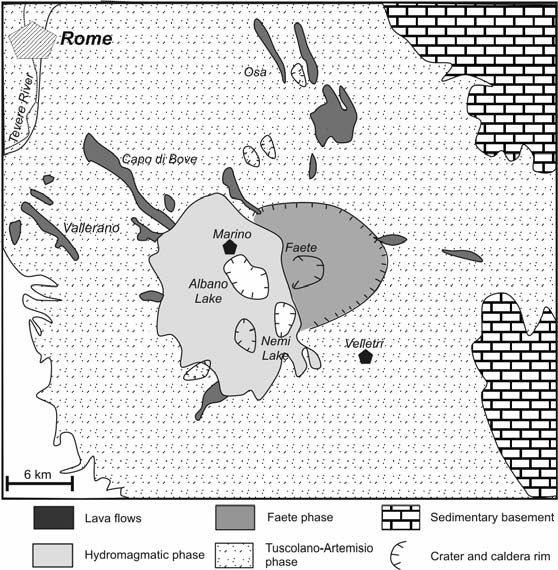Alban Hills

Schematic geological map of Colli Albani volcano. Simplified after De Rita et al. (1995) and Trigila et al. (1995).
The Colli Albani (Alban Hills), also known as Vulcano Laziale, is a large stratovolcano with a central multiple caldera, located about 20 km southeast of Rome. It was constructed in an area affected by NW-SE, NE-SW, and N-S extensional and strike-slip faults. The edifice consists of dominant pyroclastic rocks and minor lavas flows, which were erupted from about 0.6 Ma until very recently, probably during early Roman times.
The volcanic rocks crop out over an area of about 1000 km2. They lie upon Plio-Pleistocene marine sands and clays that fill NW-SE trending extensional basins, developed over Tortonian pelitic-sandy flysch and thick Upper Triassic-Upper Miocene pelagic and platform carbonate units (Sabina facies and Umbria-Latium facies). The latter are believed to represent the wall rocks of the Colli Albani magma. The volcano is located on the western side of the southern end of the Ancona-Anzio tectonic line, which cuts the Italian peninsula from NE to SW, and represents the southern boundary of northern Apennines.
The Colli Albani volcano has long attracted the attention of scientists, who reported important field observations and clarified several first-order volcanological, petrological and morphological features of the volcano. Volcanological and geochronological studies have resulted in the recognition of three main phases of activity at Colli Albani:
1. The Tuscolano-Artemisio phase (about 0.6 to 0.3 Ma), which built up the main cone and was concluded by a caldera collapse.
2. The Faete phase (or Campi di Annibale phase; 0.3 to 0.2 Ma), during which activity was from the intra-caldera Faete cone and resulted in an intra- caldera collapse.
3. The hydromagmatic phase (0.20 to about 0.02 Ma), characterised by violent phreatomagmatic explosions.
The Tuscolano-Artemisio phase erupted about 280 km3 of volcanic products, mostly consisting of ignimbrites and subordinate fall deposits. The biggest ignimbrite eruption of this phase (about 350 ka) formed a large unwelded massive pyroclastic flow (Villa Senni Tuff) and caused the caldera collapse. Syn-to post-caldera strombolian activity and lava effusions took place along the caldera fractures.
The Faete phase erupted about 6 km3 of volcanic products, which formed the Monte Faete lava and scoria cone, an intra-caldera massive pyroclastic flow deposit (Campi di Annibale pyroclastics), and some flank lava flows. The activity of the Faete phase was closed by the collapse of the Campi di Annibale nested caldera and by circum-caldera strombolian eruptions.
The final hydromagmatic phase occurred from several explosion craters mainly located in the western sector of the volcano, and produced about 1 km3 of pyroclastic surge, flow and lahar deposits and very few lavas. The best known explosion craters include the maars of Nemi and Albano lakes. The youngest measured age, obtained by thermoluminescence methods on wet pyroclastic flow deposits from the Albano crater, yields a date of about 19 ka.
There is considerable debate on the present condition of the Colli Albani volcano. As mentioned earlier, shallow seismicity has been repeatedly registered. Moreover, historical documents from Roman authors report on phenomena, such as rain of stones, sudden explosions and fires, which can be ascribed to volcanic eruptions. Moreover, findings of pre-Roman pottery and other human artefacts beneath pyroclastic products are considered as an evidence of a volcanic activity which is much younger than the latest dated rock. Therefore, based on archaeological and historical records and on seismicity, the volcano is now considered in a quiescent state.
The Colli Albani rocks have a silica underaturated ultrapotassic composition, and range from tephrite to foidite (leucitite) and tephriphonolite. Lava flows are more mafic than pyroclastic rocks from the same eruptive phase, but ranges in silica and alkalies are similar.
Most lava flows exhibit poorly porphyritic textures. Main phenocryst phases include leucite and clinopyroxene; olivine and Fe-Ti oxides occur in minor amounts. Groundmass contains the same phases plus nepheline, melilite, phlogopite and some calcite. Notably, plagioclase is virtually absent in the Colli Albani rocks, except for rare microcrysts observed in the groundmass of some lavas. Pyroclastic rocks include scoria and pumices, which show variably porphyritic textures with dominant leucite phenocrysts and minor clinopyroxene, some mica, and rare olivine, set in a microcrystalline to glassy matrix that has been generally affected by strong secondary processes, with abundant zeolites and clay minerals. Accessory phases include Fe-Ti oxides, apatite and rare garnet.
The Colli Albani pyroclastic deposits contain abundant xenoliths of various compositions and origin. These include fragments of lava flows and several microgranular rocks that represent intrusive equivalents of erupted lavas, cumulate lithologies, and skarns. Some xenoliths are rich in kalsilite and have a composition resembling kamafugitic lavas of the Umbria volcanoes. Xenoliths often contain exotic minerals such as uranpyrochlore, Th-rich britholite, cuspidine, baddeleyite, and perovskite.
Bibliography
• Peccerillo. A. Plio-Quaternary Volcanism in Italy. (2005)



.jpg)
.jpg)
.jpg)
.jpg)
.jpg)
.jpg)
.jpg)
.jpg)
.jpg)
.jpg)
.jpg)
.jpg)
.jpg)
.jpg)
.jpg)
.jpg)
.jpg)
.jpg)
.jpg)
.jpg)
.jpg)
.jpg)
.jpg)
.jpg)
.jpg)
.jpg)
.jpg)
.jpg)
.jpg)
.jpg)
.jpg)
.jpg)
.jpg)